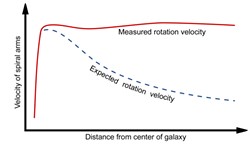[
{
"name": "Top Stories Video Pair",
"insertPoint": "7",
"component": "17087298",
"parentWrapperClass": "fdn-ads-inline-content-block",
"requiredCountToDisplay": "1"
}
]
In the 2008 movie Ghost Town, dentist Bertram Pincus (Ricky Gervais) starts seeing ghosts after a near-death experience. For every "regular" person on the sidewalks of New York, he's aware of maybe five dead people. This is something like the situation that astronomers now face. Lurking behind every part of ordinary matter are five parts of dark matter whose name mirrors our ignorance, much as mapmakers of old used the phrase terra incognita to mask theirs.
Ordinary (technically, baryonic) matter in this context is the atomic stuff from which you and I and stars and starfish are made. Atoms, having electric charge, interact with other atoms, generating detectable electromagnetic radiation in the process. On the other hand, there's dark matter. While "matter" refers to mass (all mass has a gravitational signature), "dark" means that it lacks electric charge, so we can't see it or detect it with, for instance, optical, radio or X-ray telescopes. To all intents and purposes, it's invisible.
The story of dark matter began in 1933, when Swiss astronomer Fritz Zwicky discovered a huge discrepancy in the calculated masses of galaxies in the Coma cluster when using two independent methods: luminosity (the intrinsic brightness of a galaxy is a rough measure of its mass), and motion (a galaxy's kinetic energy, and hence mass, can be inferred from rotational velocity). Zwicky found that the outer arms of spiral galaxies were rotating much faster than predicted by the "luminosity mass." To account for the inconsistency, he proposed that galaxies must be flooded with massive unseen particles: "dark matter."
Scientists were slow to accept Zwicky's ideas, in part because of his abrasive personality - he suffered neither fools nor criticism lightly - and it took 40 years for his galactic rotation "discrepancy" to be corroborated. Vera Rubin, a young astronomer at the Carnegie Institution of Washington, used a new super-sensitive spectrograph to show, beyond all doubt, that the stars at the outer edge of the Andromeda galaxy were moving faster than predicted: Absent missing mass, they should have been zipping off into space (see diagram). Today, astronomers are confident that most galaxies are dominated by dark matter, in a ratio of roughly five parts of dark (or transparent) matter to one part of ordinary (visible) matter.
We can't see dark matter. It seems to only interact gravitationally (and, perhaps, via the weak nuclear force) with ordinary matter. So ... what is it? Astronomers would dearly like to know, and every year brings a new crop of theories. The most popular conjecture is that the cosmos is full of invisible, nearly undetectable (and aptly named) WIMPs, Weakly Interacting Massive Particles. Or if that's not vague enough for you, maybe dark matter consists of axions - named after the laundry detergent (supposedly axions would "clean up" cosmological problems). Or sterile neutrinos. Or ... .
Bottom line, we really haven't a clue what 80 percent of matter in the universe consists of. And it only gets worse, since the matter in the universe is only one quarter of the net contents of the universe; the rest is dubbed "dark energy" (see pie chart). Which you won't be reading about here: I can't fake a whole column about that.
Regarding another matter: Last week, reader James Kennedy took me to task ("Truth vs. truth," Mailbox) for my characterization of global warming. I'll clarify: I don't claim to know either the truth or The Truth about global warming. Even the Intergovernmental Panel on Climate Change only argues for 90-percent certainty that global warming is, at least partially, caused by human activity. (The major unknown is whether clouds add to or subtract from net warming.)
What is true is that, since 2007, not a single major scientific body has dissented from the IPCC conclusion. While there's always room for argument - that's the nature of science - the overwhelming consensus is, "We're screwing up the climate!"
Barry Evans ([email protected]) and his wife Louisa Rogers will be giving a slide lecture on their recent trip to Colombia at 1 p.m. in the Eureka (Main) Library on Saturday April 16 (free).
more from the author
-
Doubting Shakespeare, Part 1: Stratfordians vs. anti-Stratfordians
- Apr 25, 2024
-
A Brief History of Dildos
- Apr 11, 2024
-
Eclipse!
- Mar 28, 2024
- More »
Latest in Field Notes
Readers also liked…
-
Trouble on the Line: The Reality Part 2
- Nov 3, 2022

































